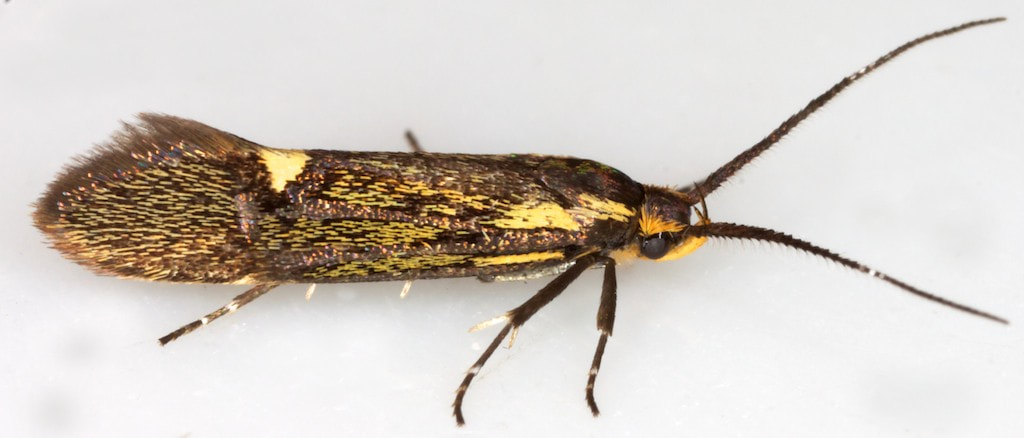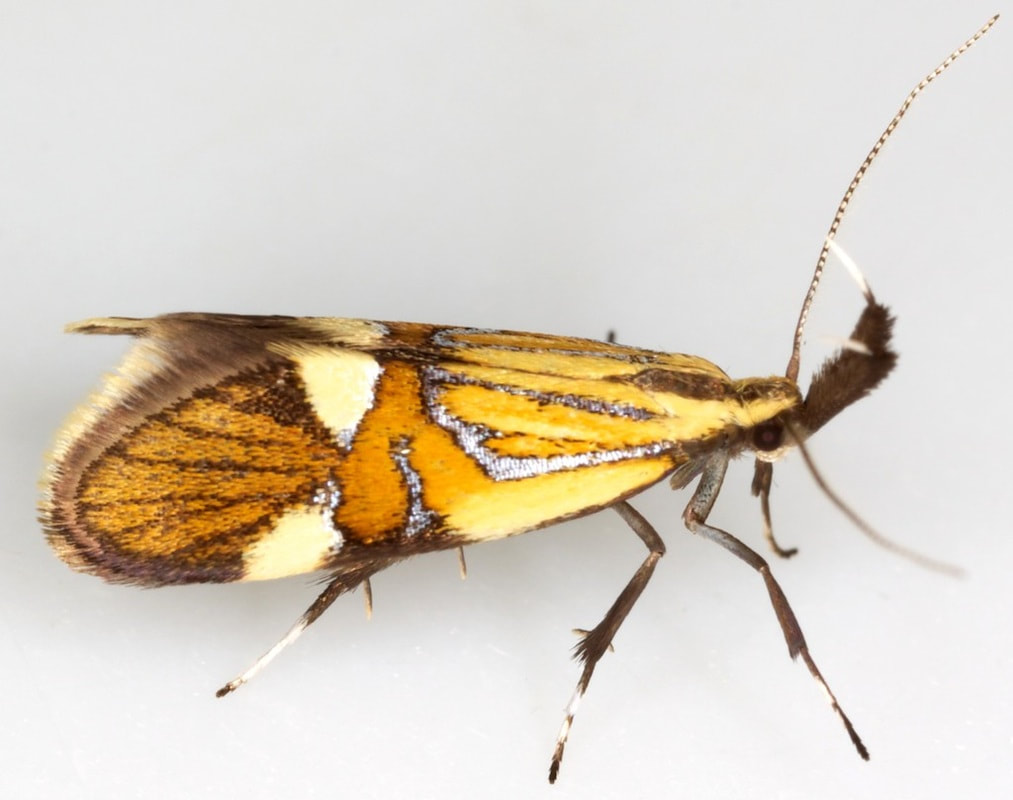Suborder:Glossata Infraorder:Heteroneura Superfamily:Gelechioidea
As treated in MBGBI4.1 Oecophoridae was a large and diverse family with no apparent morphological features identifying a moth as belonging to this family and excluding all others. It has now been broken up so that the current concept of the family only contains the subfamilies Oecophorinae and Philobotinae of MBGBI4.1. These two now are considered together in Subfamily: Oecophorinae and split at Tribe level (Oecophorini and Philobotini). All British species are now in Subfamily: Oecophorinae.
MBGBI4.1's Subfamily Chimabachinae is now Family 29: Chimabachidae. Subfamily Amphisbatinae is now Family 30: Lypusidae.
Subfamily Carcininae is now Family 31: Peleopodidae. Subfamily Depressariinae is now Family 32 Depressariidae.
Subfamily Stathmopodinae is now Family 42: Stathmopodidae.
ws: 7-30mm; Body held horizontally at rest with wings tectiform or flat and overlapping and antennae alongside body below wings
Head smooth, Ocelli absent, Proboscis well-developed; Antennae at least 3/5 fw length; scape usually with pecten
Labial palps moderate to long, usually upcurved
Fw lanceolate to to broadly ovate or subquadrate, Hw lanceolate to ovate; Hindtibia hairy
Keyed as: 1. hw cilia longer than hw breadth > head smooth-scaled > hindtibia without long bristles > head with scales broader than shaft of antenna > hw oval not produced at apex OR 2. hw cilia shorter than hw breadth > frenulum present > proboscis developed, scaled > hindtibia evenly long-haired > hw oval or broad oblong, not produced at apex (This will key to all families formerly contained in Oecophoridae except Stahmopodidae. Ethmiidae and some Gelechiidae also key here)
As treated in MBGBI4.1 Oecophoridae was a large and diverse family with no apparent morphological features identifying a moth as belonging to this family and excluding all others. It has now been broken up so that the current concept of the family only contains the subfamilies Oecophorinae and Philobotinae of MBGBI4.1. These two now are considered together in Subfamily: Oecophorinae and split at Tribe level (Oecophorini and Philobotini). All British species are now in Subfamily: Oecophorinae.
MBGBI4.1's Subfamily Chimabachinae is now Family 29: Chimabachidae. Subfamily Amphisbatinae is now Family 30: Lypusidae.
Subfamily Carcininae is now Family 31: Peleopodidae. Subfamily Depressariinae is now Family 32 Depressariidae.
Subfamily Stathmopodinae is now Family 42: Stathmopodidae.
ws: 7-30mm; Body held horizontally at rest with wings tectiform or flat and overlapping and antennae alongside body below wings
Head smooth, Ocelli absent, Proboscis well-developed; Antennae at least 3/5 fw length; scape usually with pecten
Labial palps moderate to long, usually upcurved
Fw lanceolate to to broadly ovate or subquadrate, Hw lanceolate to ovate; Hindtibia hairy
Keyed as: 1. hw cilia longer than hw breadth > head smooth-scaled > hindtibia without long bristles > head with scales broader than shaft of antenna > hw oval not produced at apex OR 2. hw cilia shorter than hw breadth > frenulum present > proboscis developed, scaled > hindtibia evenly long-haired > hw oval or broad oblong, not produced at apex (This will key to all families formerly contained in Oecophoridae except Stahmopodidae. Ethmiidae and some Gelechiidae also key here)
Tribe: Oecophorini (15G 22S)
Denisia (4S) 1EX
Borkhausenia (2S) 1EX
Crassa (2S)
Batia (3S)
Tachystola
Tribe: Pleurotini (3G 4S) [1CI]
|
Barea
|
Trachypepla
|
|
028 Barea asbolaea
(Tasmanian Concealer) Recently naturalised introduction only found in Cornwall so far, first recorded 2004 |
029 Trachypepla contritella
(Kiwi Enigma) New to Britain 2012. Has been found at light in Bedfordshire and Huntingdonshire |
Page published 20/11/2011 | Amended to reflect taxonomic change 10/03/2014



















